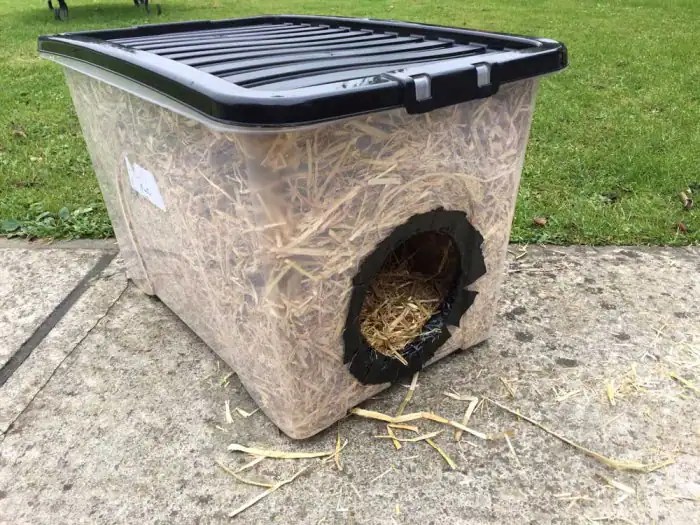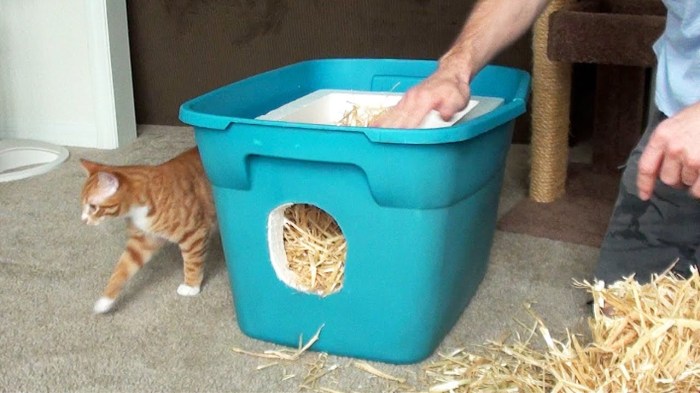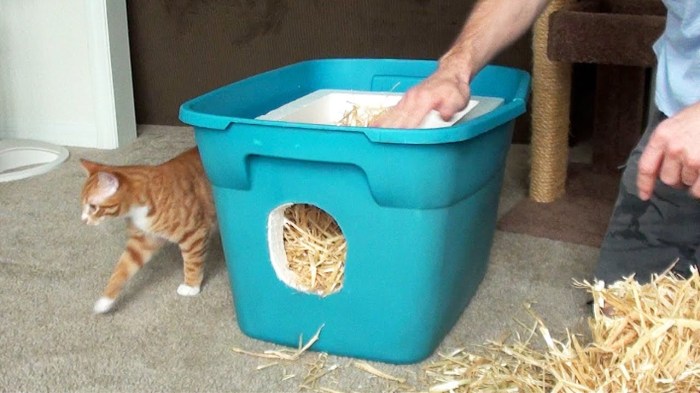DIY feral cat shelter offers a compassionate and effective way to help these often overlooked animals. Feral cats, descendants of domesticated cats that have adapted to living in the wild, face numerous challenges, including harsh weather, lack of food, and exposure to predators. By providing shelter, you can create a safe haven for these cats and improve their chances of survival.
This comprehensive guide will explore the essential steps involved in building a DIY feral cat shelter, from choosing the right location to creating a comfortable and secure environment. We’ll cover design tips, materials, insulation, and weatherproofing techniques, ensuring your shelter provides adequate protection for the cats throughout the year. Additionally, we’ll discuss food and water sources, safety considerations, and community engagement strategies to support your efforts.
Safety Considerations

Building a safe and secure shelter for feral cats is crucial for their well-being and for the safety of those who interact with the shelter. This section will explore potential safety hazards for both cats and humans and provide tips for mitigating these risks.
Securing the Shelter from Predators and Intruders
Protecting the shelter from predators and intruders is vital to ensure the cats’ safety.
- Solid Construction: The shelter should be made of sturdy materials that can withstand the elements and potential attacks. Consider using plywood, metal, or a combination of both for the walls and roof.
- Secure Entry Points: All entry and exit points should be well-secured. This includes using strong hinges and latches on doors, and ensuring any gaps or holes are sealed. For example, using a heavy-duty door with a latch that can be secured with a padlock will deter intruders and predators.
- Elevated Placement: Placing the shelter off the ground on a platform or sturdy stand can help deter predators like raccoons and stray dogs from accessing the shelter. For example, placing the shelter on cinder blocks or a raised wooden platform will make it more difficult for predators to reach the cats.
- Camouflage: Camouflaging the shelter can help make it less visible to predators. Consider painting the shelter in natural colors or using natural materials like branches and leaves to blend it in with the surroundings.
Community Engagement

Engaging the community is crucial for successful feral cat care. By fostering a network of concerned individuals, you can create a supportive environment for both the cats and those who care for them.
Benefits of a Local Network
A local network of cat caretakers provides numerous benefits, including:
- Shared Resources: A network can pool resources like food, traps, and veterinary care, making it more affordable and efficient to care for feral cats.
- Increased Knowledge and Expertise: Collaboration allows for sharing knowledge and best practices, leading to more effective care strategies.
- Improved Community Awareness: A network can raise awareness about feral cat issues and promote responsible pet ownership, reducing the number of unwanted cats.
- Enhanced Advocacy: A united community can advocate for policies that support humane feral cat management, such as trap-neuter-return (TNR) programs.
Fostering Collaboration and Support
- Organize Community Meetings: Regular meetings provide a platform for sharing information, discussing challenges, and coordinating efforts.
- Establish a Communication Channel: Utilize social media groups, email lists, or online forums to facilitate communication and information sharing.
- Offer Training and Workshops: Provide training on topics such as TNR techniques, cat behavior, and colony management to equip volunteers with the necessary skills.
- Recognize and Appreciate Volunteers: Acknowledge the efforts of volunteers through recognition events, newsletters, or public appreciation.
Ethical Considerations: Diy Feral Cat Shelter

Providing shelter for feral cats raises ethical questions about their welfare and the potential impact on the environment. While offering a safe haven for these animals seems compassionate, it’s crucial to consider the broader implications.
Population Control
The ethical considerations surrounding feral cat populations are complex. While providing shelter can improve individual cat welfare, it can also contribute to population growth.
- Arguments for Population Control: One argument for population control is the potential for feral cats to prey on native wildlife, disrupting ecosystems and endangering vulnerable species. Additionally, uncontrolled populations can lead to health issues like disease outbreaks and competition for resources.
- Arguments Against Population Control: Conversely, opponents of population control methods often cite concerns about animal cruelty and the effectiveness of these methods. They may argue that humane trapping and sterilization programs are costly and time-consuming, and that other approaches like education and responsible pet ownership are more effective in the long run.
Responsible Pet Ownership, Diy feral cat shelter
Responsible pet ownership plays a crucial role in addressing the ethical considerations surrounding feral cat populations. It’s essential to:
- Spay or Neuter Pets: This is a fundamental step in preventing unwanted litters and reducing the number of cats that end up abandoned or become feral.
- Keep Cats Indoors or Supervise Outdoor Access: This helps prevent cats from roaming and potentially contributing to feral cat populations.
- Microchip Pets: Microchipping allows lost pets to be reunited with their owners, reducing the chances of them becoming feral.
Creating a DIY feral cat shelter is a rewarding experience that allows you to make a real difference in the lives of these animals. By providing shelter, you can contribute to their well-being and help them thrive in their environment. Remember, a well-designed and maintained shelter can offer feral cats a sense of security, protection from the elements, and a place to rest and recover. With careful planning and a compassionate approach, you can create a haven for these often-forgotten creatures and make a positive impact on their lives.
Building a DIY feral cat shelter can be a rewarding way to help these animals survive the harsh elements. You can use simple materials like wood and plywood, and even incorporate a bit of creativity with some colorful paint. If you’re looking for a more unique touch, you might consider adding a decorative element like a custom-made epoxy table, like the ones featured on this website.
While an epoxy table might not be a necessity for your cat shelter, it’s a great way to add a personal touch and enhance the overall look of your project. No matter what you choose, a well-constructed shelter can make a big difference in the lives of these often overlooked creatures.

